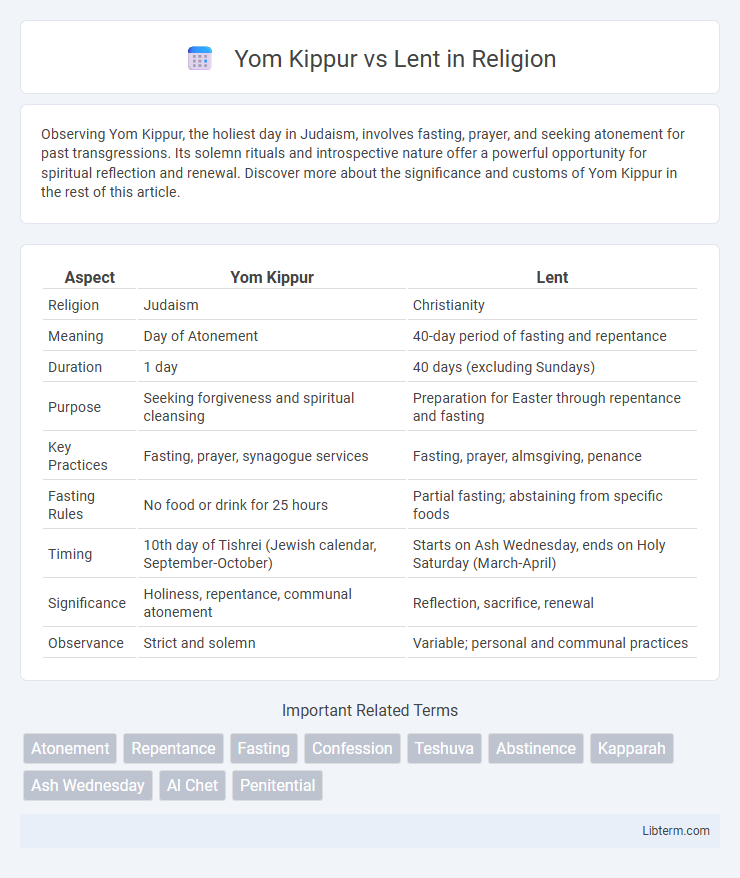Observing Yom Kippur, the holiest day in Judaism, involves fasting, prayer, and seeking atonement for past transgressions. Its solemn rituals and introspective nature offer a powerful opportunity for spiritual reflection and renewal. Discover more about the significance and customs of Yom Kippur in the rest of this article.
Table of Comparison
| Aspect | Yom Kippur | Lent |
|---|---|---|
| Religion | Judaism | Christianity |
| Meaning | Day of Atonement | 40-day period of fasting and repentance |
| Duration | 1 day | 40 days (excluding Sundays) |
| Purpose | Seeking forgiveness and spiritual cleansing | Preparation for Easter through repentance and fasting |
| Key Practices | Fasting, prayer, synagogue services | Fasting, prayer, almsgiving, penance |
| Fasting Rules | No food or drink for 25 hours | Partial fasting; abstaining from specific foods |
| Timing | 10th day of Tishrei (Jewish calendar, September-October) | Starts on Ash Wednesday, ends on Holy Saturday (March-April) |
| Significance | Holiness, repentance, communal atonement | Reflection, sacrifice, renewal |
| Observance | Strict and solemn | Variable; personal and communal practices |
Introduction to Yom Kippur and Lent
Yom Kippur, the Jewish Day of Atonement, is observed through fasting and intensive prayer, aiming for spiritual reflection and repentance. Lent, a significant Christian season lasting 40 days before Easter, emphasizes fasting, prayer, and penance to prepare believers for resurrection celebration. Both observances underscore themes of purification, self-discipline, and renewal within their respective religious traditions.
Historical Origins and Development
Yom Kippur, rooted in ancient Jewish tradition, traces back to biblical times as the Day of Atonement, established in Leviticus 16 to purify sins and renew the covenant with God. Lent emerges from early Christian practices in the 4th century, developing from the 40-day fast commemorating Jesus Christ's fasting in the desert, symbolizing penance and preparation for Easter. Both observances evolved through centuries, reflecting distinct religious, cultural, and theological developments within Judaism and Christianity.
Core Religious Significance
Yom Kippur, the Jewish Day of Atonement, centers on repentance, fasting, and seeking forgiveness to cleanse sins and restore spiritual purity. Lent in Christianity symbolizes Christ's 40-day fasting and reflection period, dedicated to penance, self-denial, and preparation for Easter. Both observances emphasize spiritual renewal but differ in rituals and theological foundations, with Yom Kippur focusing on communal atonement and Lent on individual repentance and resurrection anticipation.
Key Rituals and Practices
Yom Kippur involves a 25-hour fast, intensive prayer, and synagogue services focusing on repentance and atonement, while Lent includes fasting, prayer, and almsgiving over 40 days to prepare for Easter. Yom Kippur rituals emphasize communal confession and seeking forgiveness from God, with specific prayers like the Kol Nidre and Neilah services. Lent practices often feature abstaining from meat on Fridays and engaging in spiritual reflection and penance.
Duration and Timing
Yom Kippur lasts for approximately 25 hours, beginning at sunset on the 9th of Tishrei in the Hebrew calendar, typically falling in September or October. Lent spans 40 days, starting on Ash Wednesday and ending on Holy Saturday, usually observed between February and April in the Gregorian calendar. The timing of Yom Kippur is fixed within the Jewish calendar, while Lent's timing varies yearly with the date of Easter.
Fasting and Dietary Observances
Yom Kippur involves a strict 25-hour fast abstaining from all food and drink, including water, to achieve spiritual atonement. Lent primarily consists of partial fasting, such as abstaining from meat on Fridays and limiting meal portions, often lasting 40 days. Both observances emphasize self-denial and reflection, but Yom Kippur's fast is more rigorous and time-bound compared to Lent's extended and varied dietary practices.
Themes of Repentance and Forgiveness
Yom Kippur and Lent both emphasize themes of repentance and forgiveness, serving as profound spiritual periods for reflection and atonement. Yom Kippur, the Jewish Day of Atonement, centers on seeking forgiveness from God and fellow humans through fasting, prayer, and confession. Lent, observed by Christians, involves forty days of fasting, prayer, and penitence, focusing on repentance and the ultimate forgiveness offered through Jesus Christ's sacrifice.
Community and Worship Activities
Yom Kippur involves intense communal worship with extended synagogue services, including fasting and collective prayers like the Vidui confession, fostering unity among participants. Lent engages Christian communities through practices such as fasting, prayer, almsgiving, and attending church services that emphasize reflection and repentance over 40 days. Both observances strengthen communal bonds by encouraging shared spiritual discipline and collective acts of devotion.
Differences in Spiritual Focus
Yom Kippur centers on atonement and repentance through fasting, prayer, and solemn reflection, aiming for forgiveness and spiritual purification within the Jewish tradition. Lent emphasizes penitence and self-denial over 40 days, preparing Christians for Easter by focusing on sacrifice, renewal, and aligning with the suffering of Jesus Christ. The spiritual focus of Yom Kippur is communal reconciliation with God, while Lent highlights individual transformation and growth in faith.
Contemporary Observance and Adaptation
Contemporary observance of Yom Kippur involves a 25-hour fast, prayer, and synagogue services focusing on repentance and self-reflection, often adapted with virtual participation and community support to accommodate modern lifestyles. Lent, traditionally a 40-day period of fasting, prayer, and almsgiving, has evolved with many Christians choosing personalized sacrifices or digital devotionals rather than strict fasting. Both practices have integrated technology and contemporary social awareness, reflecting evolving spiritual needs while maintaining core themes of penance and renewal.
Yom Kippur Infographic

 libterm.com
libterm.com